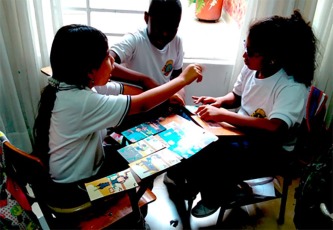Elsevier, Telematics and Informatics, Volume 38, May 2019
Currently, learning technologies are transforming and modifying educational systems with impressive progress of Information and Communication Technologies. Furthermore, when these technologies are available, accessible, usable and affordable, they represent more than just a transformation for people with disabilities, they represent real opportunities with access to an inclusive education and help to overcome the obstacles they meet in classical educational systems.
Elsevier, Research Policy, Volume 48, May 2019
To what extent is scientific research related to societal needs? To answer this crucial question systematically we need to contrast indicators of research priorities with indicators of societal needs. We focus on rice research and technology between 1983 and 2012. We combine quantitative methods that allow investigation of the relation between ‘revealed’ research priorities and ‘revealed’ societal demands, measured respectively by research output (publications) and national accounts of rice use and farmers’ and consumers’ rice-related needs.
Elsevier, Energy, Volume 175, 15 May 2019
This article shows that research in the design of 100% renewable energy systems in scientific articles is fairly new but has gained increasing attention in recent years. In total, 180 articles published since 2004 have been identified and analysed. Many of these articles have a predominant focus on the electricity sector. However, an increasing number of studies apply a cross-sectoral holistic approach on the entire energy system.
Elsevier, Progress in Disaster Science, Volume 1, May 2019
This viewpoint reviews key assessments from the IPCC Special Report on Global Warming of 1.5 °C and examines the implications for the Sendai Framework for Disaster Risk Reduction (SFDRR). Disaster risks are expected to be higher at 1.5 °C and continue to increase at 2 °C. Current and future disaster risk management particularly those that deal with the impacts of coastal flooding, heat-related health impacts, sea level rise, and forest fires are to be strengthened, particularly the Arctic, Caribbean, SIDS and low-lying coastal areas are particularly at risk.
Elsevier, Progress in Disaster Science, Volume 1, May 2019
The UN has adopted the Sendai Framework for Disaster Risk Reduction (2015–2030; SFDRR) in March 2015 and the member countries agreed to shift from disaster management to disaster risk management. The SFDRR is in line with the UN Sustainable Development Goals (SDGs; September 2015). In 2016, the UNISDR together with partner organizations has prepared roadmap for mainstreaming Science and Technology in SFDRR. Out of four priority areas, this paper focuses on the appraisal of challenges in SFDRR priority 1 “understanding disaster risk” through the lens of science, technology and innovations.
Elsevier, Neuron, Volume 102, 22 May 2019
Healthy psychological and brain development is not a privilege, but a fundamental right that requires special protections and opportunities for building cognitive, emotional, and social skills necessary for becoming a contributing member of our society. Healthy psychological and brain development is not a privilege, but a fundamental right that requires special protections and opportunities for building cognitive, emotional, and social skills necessary for becoming a contributing member of our society.
Elsevier, Soil and Tillage Research, Volume 188, May 2019
At the 21st session of the United Nations Framework Convention on Climate Change (UNFCCC, COP21), a voluntary action plan, the ‘4 per 1000 Initiative: Soils for Food Security and Climate’ was proposed under the Agenda for Action. The Initiative underlines the role of soil organic matter (SOM) in addressing the three-fold challenge of food and nutritional security, adaptation to climate change and mitigation of human-induced greenhouse gases (GHGs) emissions. It sets an ambitious aspirational target of a 4 per 1000 (i.e.
Elsevier, Pedobiologia, Volume 74, May 2019
It has long been established that the spatial scale of inquiry affects the ecological patterns that are revealed. However, studies of the ecological drivers underlying the assembly of soil animal communities rarely adopt a multi-scale perspective. Here, we quantified the distribution of oribatid richness along a chronosequence of temperate hardwood forests in a deglaciated region of eastern North America and analyzed variation in oribatid community structure at two grain sizes: 0.1 m2 and 900 m2, and two spatial extents: 20–150 m and 80–420 km.
Elsevier, International Journal of Nursing Studies, Volume 93, May 2019
Aims and objectives/background: Nursing is a predominantly female profession. This is reflected in the demographic of nursing around the world. Some authors have noted that despite being a gendered profession men are still advantaged in terms of pay and opportunity. The aim of this study was to examine if the so called glass escalator in which men are advantaged in female professionals still exists.
Elsevier, Solar Energy Materials and Solar Cells, Volume 193, May 2019
Metal halide perovskite materials have revolutionized the solution-processed solar cells and become the vanguard of research focus with an unprecedented improvement of power conversion efficiencies up to 23.3%, which pose a remarkable challenge to thin film and multicrystalline silicon photovoltaics. Nevertheless, for conventional perovskite solar cells based on lead, it is ineluctable to take the toxicity of lead and the long-term stability of the devices into consideration when the deployment of this technology in mass production is put on the agenda.

